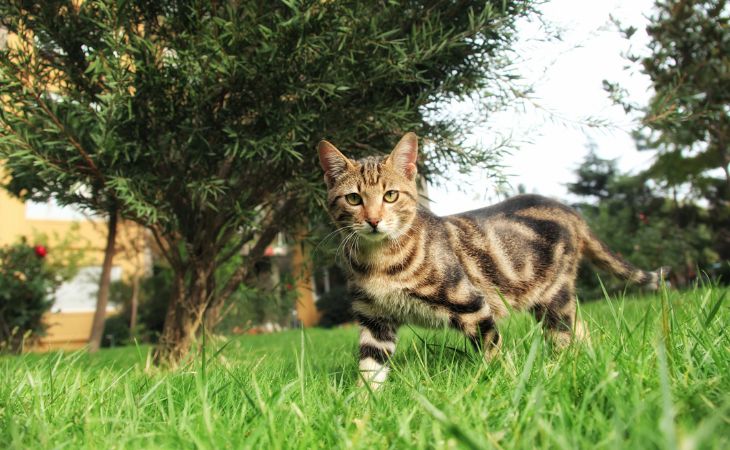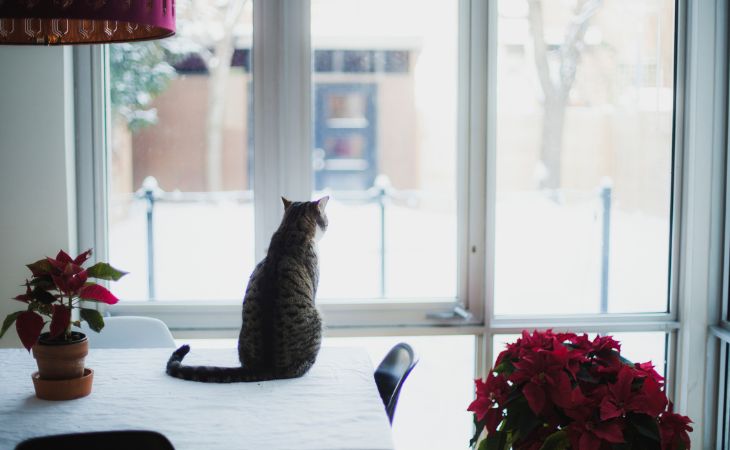Cats are hunters and they naturally feel the desire to go outside and discover what’s around them. They need mental stimulation to thrive and to not develop behavioral problems. Our furry friends are curious and in search of freedom, but it can be difficult to manage their outings. So, do we really need to let our cats go outside? If like the majority of cat parents, you ask yourself this question, we will give you some tips and advice in this article.
This article might interest you: Top 10 cat breeds that love the outdoors
Letting your cat go outside: identification
Please keep in mind that the following identification types are referring to the procedures and practices done in France.
Identification is most often carried out during the first visit to the vet. This procedure involves assigning a unique number to your cat before they reach 7 months of age. The vet can identify your feline by tattoo or electronic transponder chip. The chip is painless and much faster. They are implanted subcutaneously and contain a unique 15-digit code to identify your pet should it ever get lost.
Tattooing, on the other hand, is carried out under general anaesthetic, and in most cases at the same time as sterilization. This method is used to inscribe a series of letters and numbers directly onto the cat’s skin, on the inside of their thigh or ear.
Spaying and neutering, an important act for pet parents’ peace of mind
While it isn’t a legal obligation, in France at least, the ideal option is to spay or neuter your cat before letting them go outside. Once they are in heat, cats that are not spayed or neutered will be more inclined to search for a male or female to mate with. In addition to preventing your cat from running away, spaying and neutering also has other advantages such as:
- limiting unwanted litters: in most cases, they contribute to increasing the number of stray cats and overcrowding in shelters,
- reduced risk of uterine infection in females,
- reduced urine marking, particularly in males,
- making them easier to live together, especially if you’re adopting several felines.
Spaying and neutering also helps reduce the risk of tumors, which are often malignant in both males and females. Numerous studies have shown that early spaying of female cats helps reduce the risk of mammary tumors, which are highly aggressive in almost 90% of cases. Finally, having your pet spayed or neutered prevents them from catching sexually transmitted diseases when their out and about.
The importance of vaccination before letting your cat go outside
When your cat is outside, they are exposed to many diseases, especially if they have never been around other animals. Before letting them go outside, make sure that all their vaccines are up to date. This will protect them from contagious diseases that are common for cats. The first vaccine should normally be done after 8 or 9 weeks. During the first year, they will receive two injections, then there will be yearly vaccines.
You should also vaccinate your cat against rabies and leukemia. These diseases are transmitted when your cat is in contact with other animals. Do not hesitate to ask for advice from your vet if you have the slightest doubt.
Ticks and fleas are also frequent in outdoor cats. Therefore, treat them regularly against these pests—ideally every month. A cat that is used to going outside will be exposed to worm contaminations. They can get them if they are in contact with the feces of contaminated animals or if they find themselves in an infected environment. To prevent and fight against these parasites, ensure that your cat’s anti-parasite treatments are up to date.

Ensure the safety of your cat
Have you recently adopted a feline? Before letting your cat go out, specialists recommend waiting around 4 weeks. This lapse of time will help them get used to their new environment and mark their territory. If you let your cat go outside too early, it’s likely that they will get lost or they will try to find their old home.
A few safety habits to adopt
Once your cat has marked their territory, let your cat go outside only in the daytime to avoid nocturnal dangers. At night, it is more difficult for drivers to see your cat, which augments the risks of accidents. The lights of cars can also dazzle cats at night. In most cases, they will not know where to go and can run away.
As soon as you adopt a new kitten, get your kitten used to a harness. You can keep an eye on them better during their outings and will keep them from getting too far from your without your permanent surveillance. If you leave them outside alone, make sure to take off their collar. This precaution limits the risk of choking, if they were to try to climb an obstacle for example. Unfortunately, this can lead to death in a matter of minutes if the collar gets stuck.
Invest in safety equipment
Are you afraid of losing your cat during their outings. For more safety, equip them with a GPS tracker. These accessories can connect to mobile applications and also serve as a real time tracking system to see where your cat is going when they are outside.
Cats are predators that do not hesitate to chase birds. According to the LPO (Ligue pour la protection des oiseaux or League for the Protection of Birds in English), felines cause the death of around 324 million prey per year. Spring coincides, unfortunately, with the birth of many little chicks. To prevent your cat from running away by trying to hunt little birds, keep them at home between May and early July. Also avoid letting them go outside during the winter months.
Keep your backyard secure. Pools can be a real danger for domestic cats. While they know how to swim, they can risk drowning from getting exhausted. Therefore, put the cover back on after each time that you swim. Also, place a water bowl outside that is available for your cat to drink so that they do not try to go towards the pool to get a drink.
What are the alternatives if I decide not to let my cat go outside?
Despite all these precautions, are you still afraid to let your cat go outside? Does your pet not like to go outside? If this is the case, equip your home with a few accessories and toys that your cat can play with to ensure that they can thrive. This precaution is necessary to avoid having your cat getting bored and depressed. If your house has activities inside, they will not even wonder about going outside.
In addition to equipping your house with a litter box, give your cat a cat tree. This accessory will help your cat maintain their claws, climb, jump, sleep, and even hide. Invest in a big cat tree with different posts, areas to sleep, and levels to allow your cat to be able to enjoy themselves on it.
Putting cat grass out is also important for cat parents that do not wish to let their cats outside. It helps with digestion and helps eliminate hairballs that accumulate in the stomach.

